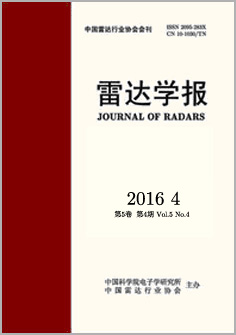| [1] |
程江华, 高贵, 库锡树, 等. 高分辨率SAR图像道路交叉口检测与识别新方法[J]. 雷达学报, 2012, 1(1): 100-108. Cheng Jiang-hua, Gao Gui, Ku Xi-shu, et al.. A novel method for detecting and identifying road junctions from high resolution SAR images[J]. Journal of Radars, 2012, 1(1): 100-108.
|
| [2] |
李光廷, 杨亮, 黄平平, 等. SAR图像相干斑抑制中的像素相关性测量[J]. 雷达学报, 2012, 1(3): 301-308. Li Guang-ting, Yang Liang, Huang Ping-ping, et al.. The pixel-similarity measurement in SAR image despeckling[J]. Journal of Radars, 2012, 1(3): 301-308.
|
| [3] |
Sauvola J and Pietikinen M. Adaptive document image binarization[J]. Pattern Recognition, 2000, 33(2): 225-236.
|
| [4] |
Otsu N. A threshold selection method from gray-level histograms[J]. IEEE Transactions on Systems, Man, and Cybernetics, 1979, 9(1): 62-66.
|
| [5] |
Zhao X, Jiang Y, and Zhang Y. Automatic binarization method in ISAR image[C]. IEEE International Geoscience and Remote Sensing Symposium, Milan, 2015: 5415-5418.
|
| [6] |
Stagliano D, Lupidi A, Berizzi F, et al.. Exploitation of COSMO-SkyMed system for detection of ships responsible for oil spills[C]. 2012 IEEE International Geoscience and Remote Sensing Symposium, Munich, 2012: 915-918.
|
| [7] |
Leng X, Ji K, Yang K, et al.. A bilateral CFAR algorithm for ship detection in SAR images[J]. IEEE Geoscience and Remote Sensing Letters, 2015, 12(7): 1536-1540.
|
| [8] |
Liao M, Wang C, Wang Y, et al.. Using SAR images to detect ships from sea clutter[J]. IEEE Geoscience and Remote Sensing Letters, 2008, 5(2): 194-198.
|
| [9] |
Mcconnell A I and Oliver C J. Comparison of segmentation methods with standard CFAR for point target detection[C]. Proceedings SPIE 3497, SAR Image Analysis, Modeling, and Techniques, 1998. doi: 10.1117/12.331364. |
| [10] |
Lankoande O, Hayat M M, and Santhanam B. Segmentation of SAR images based on Markov random field model[C]. IEEE International Conference on Systems, Man and Cybernetics, 2005, 3: 2956-2961.
|
| [11] |
HUANG Yu, FU Kun, and WU Yi-Rong. Image segmentation method using K-means based on Markov random field[J]. Acta Electronica Sinica, 2009, 37(12): 2700-2704.
|
| [12] |
Fowlkes C, Belongie S, Fan C, et al.. Spectral grouping using the Nystrm method[J]. IEEE Transactions on Pattern Analysis and Machine Intelligence, 2004, 26(2): 214-225.
|
| [13] |
Zhang X, Hao L, Liu F, et al.. Spectral clustering ensemble applied to SAR image segmentation[J]. IEEE Transactions on Geoscience and Remote Sensing, 2008, 46(7): 2126-2136.
|
| [14] |
Kusakunniran W, Wu Q, Zhang J, et al.. A new view-invariant feature for cross-view gait recognition[J]. IEEE Transactions on Information Forensics and Security, 2013, 8(10): 1642-1653.
|
| [15] |
Zhao X, Jiang Y, Stathaki T, et al.. Gait recognition method for arbitrary straight walking paths using appearance conversion machine[J]. Neurocomputing, 2015, 173(3): 530-540.
|
| [16] |
Huang G B, Zhou H, Ding X, et al.. Extreme learning machine for regression and multiclass classification[J]. IEEE Transactions on Systems, Man, and Cybernetics, Part B: Cybernetics, 2012, 42(2): 513-529.
|
| [17] |
Huang G B, Chen L, and Siew C K. Universal approximation using incremental constructive feedforward networks with random hidden nodes[J]. IEEE Transactions on Neural Networks, 2006, 17(4): 879-892.
|
| [18] |
Huang G B and Chen L. Enhanced random search based incremental extreme learning machine[J]. Neurocomputing, 2008, 71(16/18): 3460-3468.
|
| [19] |
Huang G B, Zhu Q Y, and Siew C K. Extreme learning machine: theory and applications[J]. Neurocomputing, 2006, 70(1/3): 489-501.
|
| [20] |
Gao G, Zhao L, Zhang J, et al.. A segmentation algorithm for SAR images based on the anisotropic heat diffusion equation[J]. Pattern recognition, 2008, 41(10): 3035-3043.
|




 Submit Manuscript
Submit Manuscript Peer Review
Peer Review Editor Work
Editor Work




 DownLoad:
DownLoad: